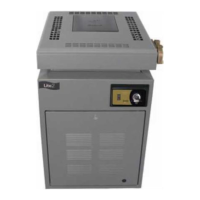Page 42
volts. If there is no voltage, replace the transformer.
To test the 12 volt transformer output, leave the black
lead of the meter at test point 1 and touch the free
lead of the meter to the transformer connector where
the white wire is attached (test point 3). The meter
should show 10-14 volts. If there is no voltage, replace
the transformer.
10.4.3.2 Fuse
Leaving the black voltmeter lead in place at test
point 1, touch the free lead to the end of the fuse (test
point 4). The meter should read 20-28 volts. If there is
no voltage, the fuse has failed. Inspect the rest of the
wiring, especially the safety circuit, to be sure that
there is no “short” such as contact of a terminal with
the heater chassis or another terminal which may have
caused the fuse to fail. Correct any such condition and
replace the fuse.
10.4.3.3 Fireman Switch and External
Interlocks
Check the voltage going to the external device.
Move the black voltmeter lead to test point 2. (This
lead can be left in place for most of the testing.)
Touch the free lead of the meter to the fireman switch
connector where the red wire is attached at the lower
end of the connector (test point 5). The meter should
read 20-28 volts. If there is no voltage, there may be a
bad connection on the power distribution board and the
board may need to be replaced. If voltage is detected
at test point 5, move the free lead of the meter to the
fireman switch connector where the other red wire is
attached at the upper end of the connector (test point
6). The meter should read 20-28 volts. If there is no
voltage, the time clock switch or other external
interlock may be mis-adjusted, mis-connected or
defective. Correct this external problem.
10.4.3.4 Fusible Link
Check the voltage going to the safety circuit.
Leave the black voltmeter lead in place at test point 2.
Touch the free lead of the meter to the safety circuit
of the six pin connector where the red wire is attached
at the lower left corner of the connector (test point 7).
The meter should read 20-28 volts. If there is no
voltage, there may be a bad connection on the power
distribution board and the board may need to be
replaced. If voltage is detected at test point 7, move
the free lead of the meter to the terminal of the fusible
link where the white wire is connected (test point C).
If no voltage is detected at test point C, the
fusible link has failed. This indicates higher than
normal temperatures in the component compartment
(vestibule). Normal component compartment tempera-
ture is well below 300
o
F. The fusible link is designed to
fail at temperatures above 305°F. Excessive tempera-
ture might be due to a blocked flue or heat exchanger.
Clean the heat exchanger and clear the flue and vent
of any restrictions. Sometimes the fusible link fails due
to flame roll-out. Flame roll-out may be caused by
delayed ignition or downdrafting in windy areas.
Thoroughly investigate the causes for flame roll-out
and correct the problem when replacing the fusible
link.
10.4.3.5 Limit Switches
Since the limit switches are not easily accessible,
you can check the voltage going into the component
after the limit switches in the circuit. If voltage is
detected there, then the limit switches are closed and
are operational.
Check the voltage going to the water pressure
switch. Leave the black voltmeter lead in place at test
point 2. Touch the free lead of the meter to the
terminal of the water pressure switch where the white
wire is connected (test point D).
If there is no voltage, one of the limit switches is
open. This is normally due to excessive water tem-
perature, which should be thoroughly investigated
before replacement of limit switches. Excessive water
temperature may be caused by low water flow. Water
flow deficiency may be due to obvious problems such
as a defective pump or blocked water filter. Alterna-
tively, excessive water temperature may be due to
over-firing, or to a problem with the water piping or
the heater's internal bypass control. Over-firing might
be a result of an incorrect gas orifice or supply of
propane gas to a heater intended for natural gas. If
there are no such fundamental problems, identify
which of the switch is open by temporarily connecting
a jumper wire across its terminals. Replace a defective
limit switch. Limit switch access is through the limit
switch cover on the side of the heater to which water
pipes are connected.
Note that the limit switches have different trip
points, and it is important that replacements are
correct. The 150°F switch has a red dot on the top of
the brass fitting, and must be installed in the lower
(horizontal) well in the header. The 135°F switch has
no dot and must be installed in the upper (vertical) well
in the header.
10.4.3.6 Water Pressure Switch
If voltage is detected at test point D, move the
free lead of the meter to the terminal of the water
pressure switch where the white wire is connected
(test point E).
If there is no voltage, the pressure switch contacts
are open. This is almost always due to a water flow
deficiency, the most common one being a blocked water
filter or defective pump. However, sometimes it is due
to blockage of the copper siphon loop tube or mis-
adjustment of the switch. Investigate thoroughly,
referring to Section 7.6 on “Adjusting the Pressure

